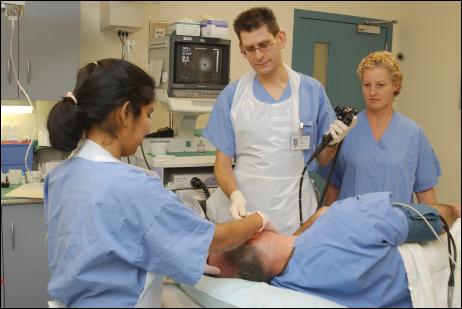Tool Can Find And Diagnose Cancers Earlier
Tool Can Find And Diagnose Cancers Earlier
North Shore Hospital, Waitemata DHB, is introducing a new Auckland-wide regional service that will allow more accurate diagnosis of the extent of cancers for hundreds of patients.

North Shore Hospital gastroenterologist Russell Walmsley and staff.
The new service, using Endoscopic Ultrasound (EUS), is the first in Auckland and will be available regionally with Auckland, Waitemata and Counties Manukau DHBs expected to refer the majority of patients. The only other similar service is in Tauranga.
EUS will be used in the diagnosis of upper gastrointestinal (UGI) cancers in the oesophagus, stomach, bile ducts, pancreas and lung. Dug 1995 to 1997 there were 170 oesophageal cancers, 410 gastric cancers and 312 pancreatic cancers diagnosed in the Auckland area. North Shore Hospital gastroenterologist Russell Walmsley will be the first doctor in Auckland to train in the technique using the EUS device, which provides 3-D imaging of lesions and growths.
He says the new technology surpasses other imaging tests providing the physician with a detailed picture of the lining of the bowel and the tissues close by to help more accurately determine whether or not a patient should have surgery or other treatments like chemotherapy and radiation.
“More patients will now have access to the best technology to assist in the early detection, management planning and staging of cancer.”
EUS has also been shown to save on bed days, and in well-defined clinical situations be the most cost effective investigation over CAT scanning and other diagnostic procedures for UGI cancers.
“CAT scanning provides accurate readings of UGI tumours in about 50-60 per cent of cases. The EUS provides more detailed information on the position, size, depth and shape of tumours, increasing accuracy to 80 to 90 per cent.”
The system uses an interface between an endoscope and ultrasound machine, providing the best picture of how to handle cancerous growths. It can also be used to take samples without the need for surgical intervention.
Many changes in cancer growths can be very subtle until they reach the size where they become unmanageable. EUS is able to identify these changes early and accurately, in many instances eliminating the need for surgery.
Earlier this year Dr Walmsley travelled to Hong Kong for training in the use of EUS but was forced to return early due to the outbreak of SARS. As part of that continuing training Dr Yuk Tong Lee from the Prince of Wales Hospital, Hong Kong will be at North Shore from September 22-26 assisting Dr Walmsley in an intense week of EUS lists.
Dr Walmsley says the EUS service will provide a focus for the co-ordination of UGI cancer care in Auckland.
Waitemata DHB CEO Dwayne Crombie says it is also hoped that North Shore Hospital will become the national training centre for the technique, so that up and coming specialist registrars will be able to set up similar units in other major cities in New Zealand.
MEDICAL
BACKGROUND: EUS is an imaging technique, developed over
the last 20 years, which allows better staging of
gastrointestinal tumours, especially of the oesophagus,
stomach and pancreas. It is now recognised as a valuable,
and in some countries (e.g. the UK), an obligatory tool in
deciding between the therapeutic options for these
malignancies. In addition EUS has roles in biliary imaging,
allows aspiration cytology of mediastinal and celiac lymph
nodes, accurate treatment of pancreatic pseudocysts and
celiac axis block for pain relief. Through more appropriate
use of investigative modalities EUS has now been shown to
save on bed days, and in well-defined clinical situations be
the most cost effective investigation over CT and ERCP (Am J
Gastroenterol 2002;97:452, and 2001;96:2900) Worldwide,
cancer services are being organised into special interest
groups to provide the best outcomes possible for patient
populations. In Auckland the Regional Upper
Gastro-Intestinal Interest Group was established in 2000 as
a first step in coordinating the care of patients with these
pathologies. There is now a world-class hepato-biliary
unit at Auckland Hospital, and Professor Iain Martin was
recently appointed as Professor of Upper GI Surgery based at
Middlemore Hospital. The time is therefore right to develop
an EUS service for the population of the Auckland Region.
North Shore is an appropriate place in view of our recent
acquisition of digital radiological services, MRI, expanded
expertise in the Gastroenterology Unit and the ease of
patient access. It is also appropriate that the largest
Health Board in Auckland play a role in the joint provision
of high-class care to the people of the region.


 University of Auckland: Tributes Flow For Much Loved Pacific Leader Melegalenu’u Ah Sam
University of Auckland: Tributes Flow For Much Loved Pacific Leader Melegalenu’u Ah Sam NZEI: Ministry Of Education Cuts Will Disproportionately Affect Pasifika
NZEI: Ministry Of Education Cuts Will Disproportionately Affect Pasifika Day One Hapai te Haeata: Call To Action For Young Filmmakers Against The Backdrop Of Funding Cuts
Day One Hapai te Haeata: Call To Action For Young Filmmakers Against The Backdrop Of Funding Cuts Toyota New Zealand: Three Races For Top Three To Decide TR86 Title
Toyota New Zealand: Three Races For Top Three To Decide TR86 Title Wellington City Council: Wellington Is All Action Stations For The Faultline Ultra Festival
Wellington City Council: Wellington Is All Action Stations For The Faultline Ultra Festival Melanie Allison: Local Playwright Casts A Spell Over Hamilton
Melanie Allison: Local Playwright Casts A Spell Over Hamilton